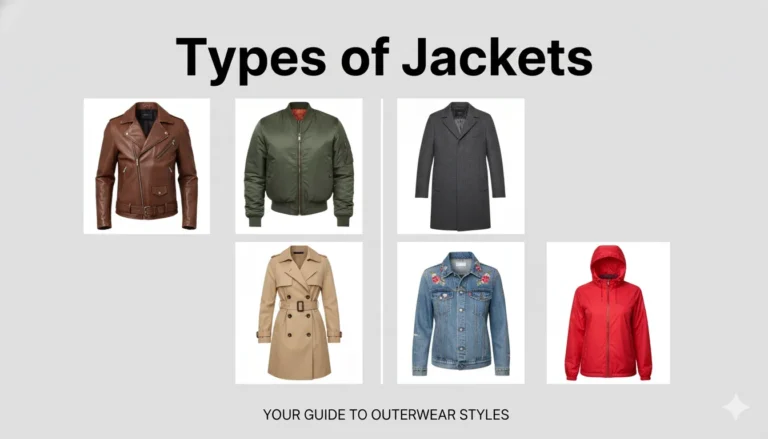Lightweight fabrics play an important role in clothing, especially for comfort and breathability. They are used to create garments that feel airy and cool, making them ideal for warmer weather and layering. These fabrics vary widely in texture, weight, and purpose.
This article explores a collection of 29 of the lightest fabrics, helping readers understand their key features and uses. Knowing about these fabrics can help people choose the right material for different types of clothing, from casual wear to formal pieces.
1) Chiffon
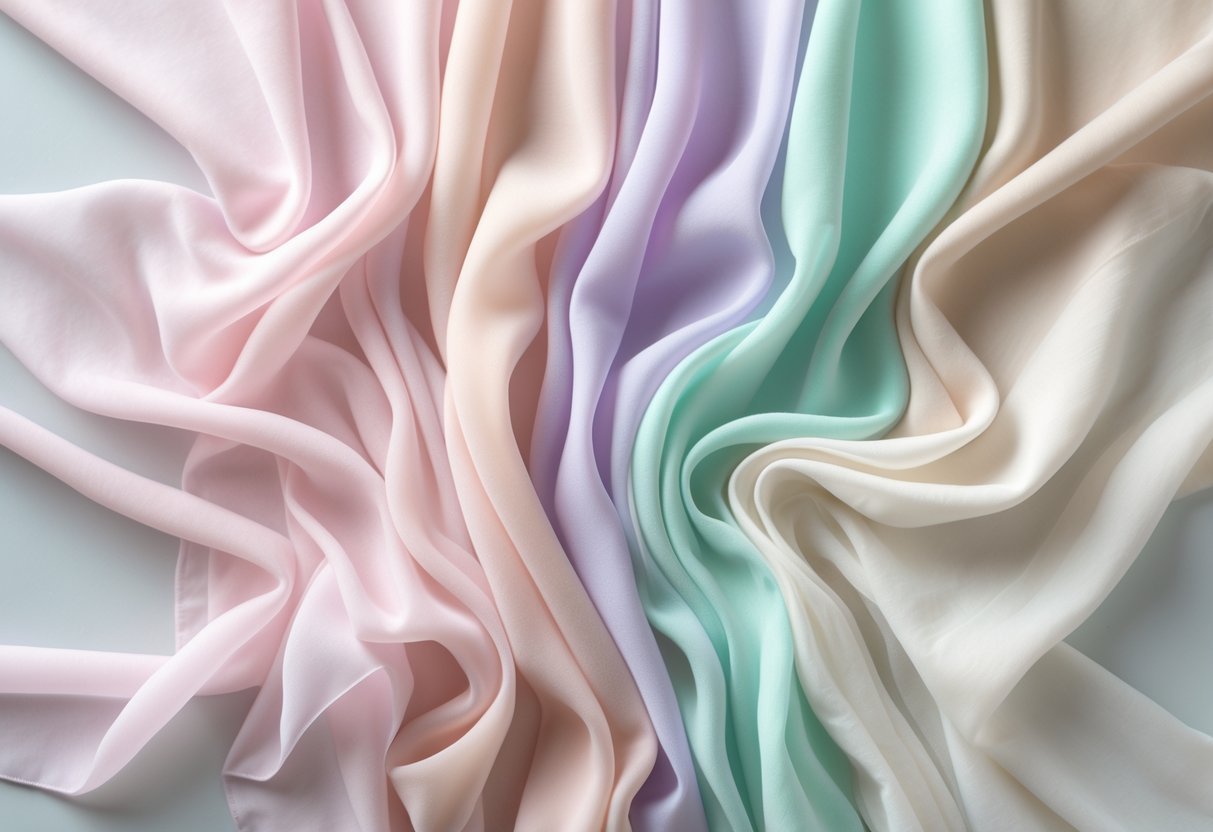
Chiffon is a lightweight, sheer fabric with a mesh-like weave. This creates a slightly transparent look that is delicate and airy.
It is made from various fibers, such as silk, polyester, and nylon. These fibers give chiffon a soft texture and a smooth drape.
Chiffon is popular for making elegant clothing like evening gowns, blouses, and scarves. Its flowing nature adds a gentle movement to garments.
The fabric requires careful handling when sewing due to its thinness. It is also delicate and can snag easily.
Chiffon can be used in layering, often as overlays on dresses, to add texture without weight. Its versatility makes it a favorite for both formal wear and lightweight accessories.
2) Cotton Voile
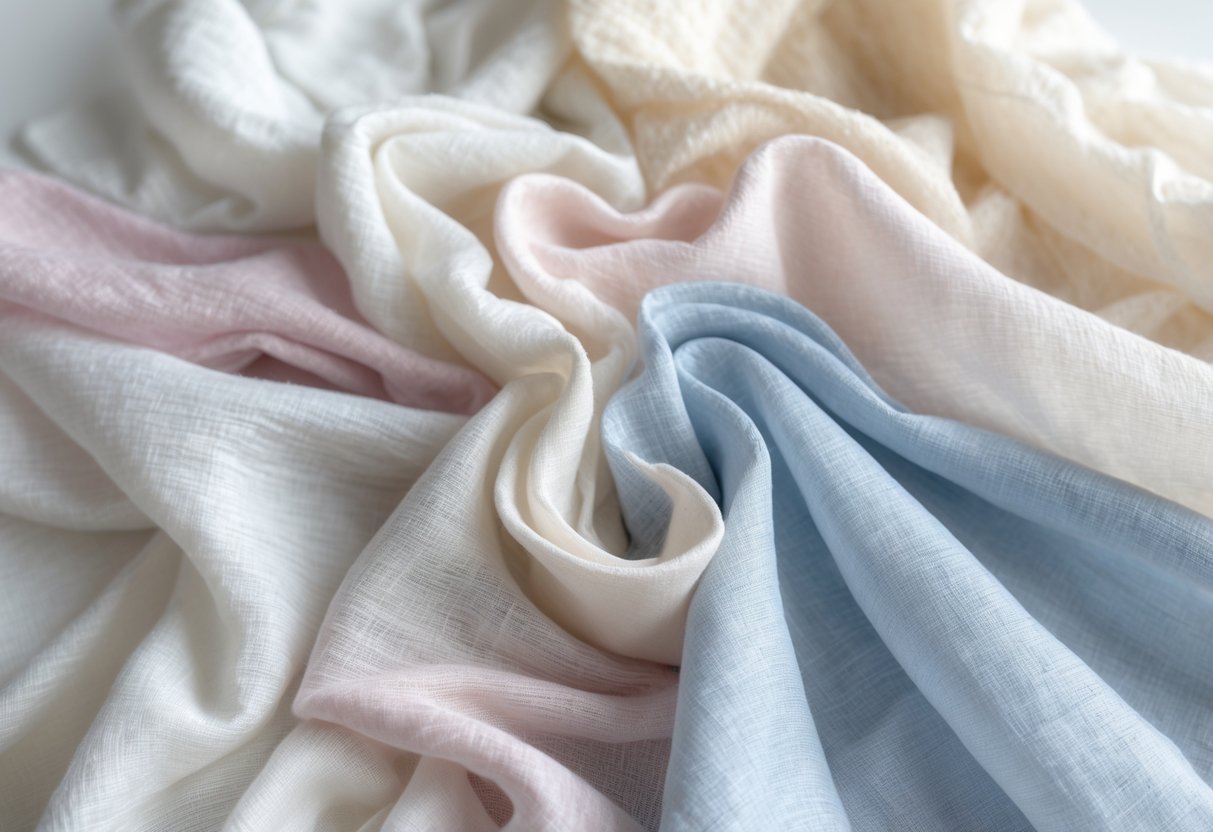
Cotton voile is a lightweight, semi-sheer fabric made primarily from cotton. It has a soft feel and a smooth texture that drapes well. This makes it a popular choice for warm-weather clothing.
The fabric is breathable and thin, which helps keep the wearer cool. It is often used for blouses, summer dresses, and skirts. Cotton voile can also serve as a lining for other garments due to its light weight.
Besides clothing, cotton voile is suitable for home décor like sheer curtains. It combines a delicate appearance with durability, making it versatile for many uses. It is also available in blends with silk or rayon, but pure cotton voile remains the most common.
3) Tencel
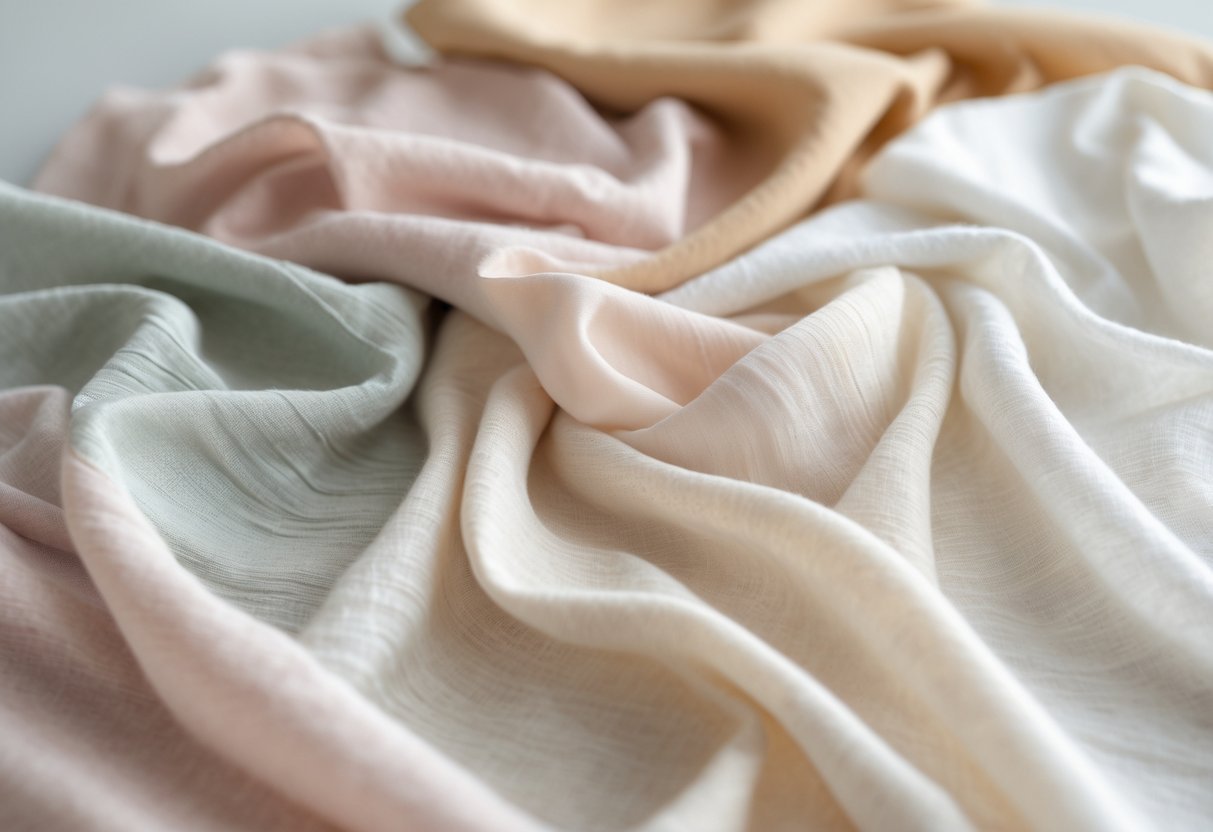
Tencel is a lightweight fabric made from wood pulp. It belongs to a group of fibers called lyocell and modal. These fibers are known for being soft and smooth to the touch.
This fabric is breathable and absorbs moisture well. It helps keep the wearer cool and dry. Tencel is also less likely to cause bacterial growth, which makes it more hygienic than some other fabrics.
Tencel drapes nicely, making it a popular choice for summer clothing such as dresses and tops. It is strong and durable, yet feels gentle on the skin. Many designers value it for its eco-friendly production process.
Because of its softness and breathability, Tencel is used in both clothing and bedding. It is often found in sustainable fashion lines. The fabric is easy to sew and manage, which makes it good for simple projects.
4) Linen

Linen is a natural fabric made from the flax plant. It is known for its breathability and softness, which makes it a popular choice for warm weather clothing. Linen allows air to pass through easily, helping to keep the wearer cool.
This fabric has a unique texture that feels smooth but slightly crisp. It also tends to be lightweight, especially in its gauze or thin woven forms, making it ideal for shirts, dresses, and summer accessories.
Linen is also valued for its durability. Despite being light, it can withstand wear and washing well. Its natural fibers do not cling to the skin, which adds to the comfort level on hot days.
Lightweight linen fabrics often weigh between 90 to 255 grams per square meter. This range includes soft, airy options that drape nicely and maintain shape without feeling heavy or stiff in clothing.
5) Organza
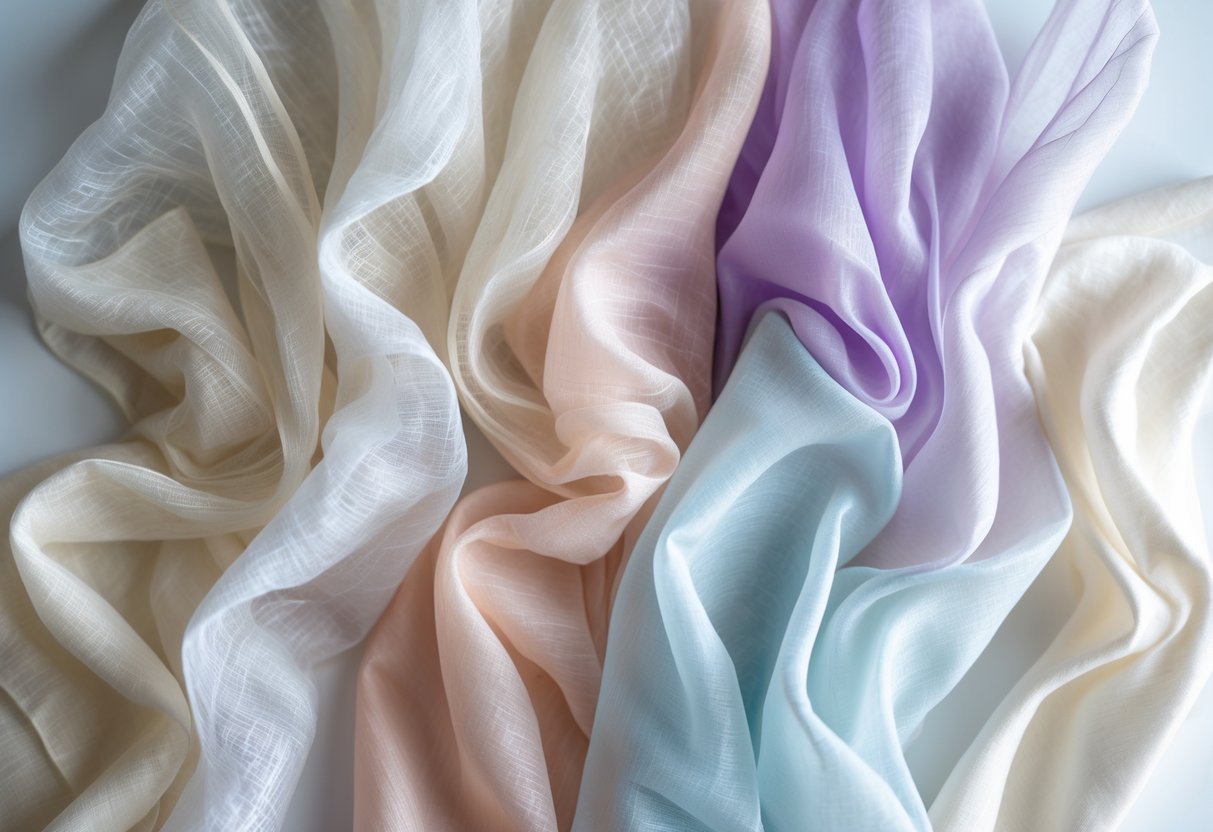
Organza is a lightweight, sheer fabric known for its crisp texture and subtle shine. It is often made from silk but can also be produced with synthetic fibers like polyester or nylon. This mix makes it more affordable and durable while keeping its delicate appearance.
The fabric has a plain weave and tightly twisted yarns. This creates a smooth, transparent surface that holds its shape well. Because of this, organza is popular in formal wear and bridal gowns.
Organza adds volume and structure without heavy weight. Designers use it for overlays, evening gowns, and decorative accents. It drapes easily but has a firm feel, giving clothes a refined and elegant look.
This fabric is also used outside fashion for home decor and party decorations. Its sheer quality and slight shimmer make it versatile for many creative projects. Organza requires careful handling, especially the silk versions, to keep its crispness and appearance.
6) Silk

Silk is one of the lightest fabrics available. It is a natural fiber produced by silkworms. This fabric is known for its smooth texture and subtle shine.
Silk is breathable and helps manage moisture, making it comfortable in warm and cool climates. It drapes well, which gives clothing a flowing, elegant look.
There are different types of silk fabrics, such as chiffon, crepe de chine, and satin. Each type varies slightly in weight and texture but remains lightweight compared to many other materials.
Silk is often used in formal wear, lightweight tops, scarves, and delicate accessories. Its softness and natural strength make it a popular choice for high-quality garments.
Due to its light weight and natural properties, silk requires gentle care during washing and handling. It is a versatile fabric suitable for a range of fashion and accessory uses.
7) Rayon
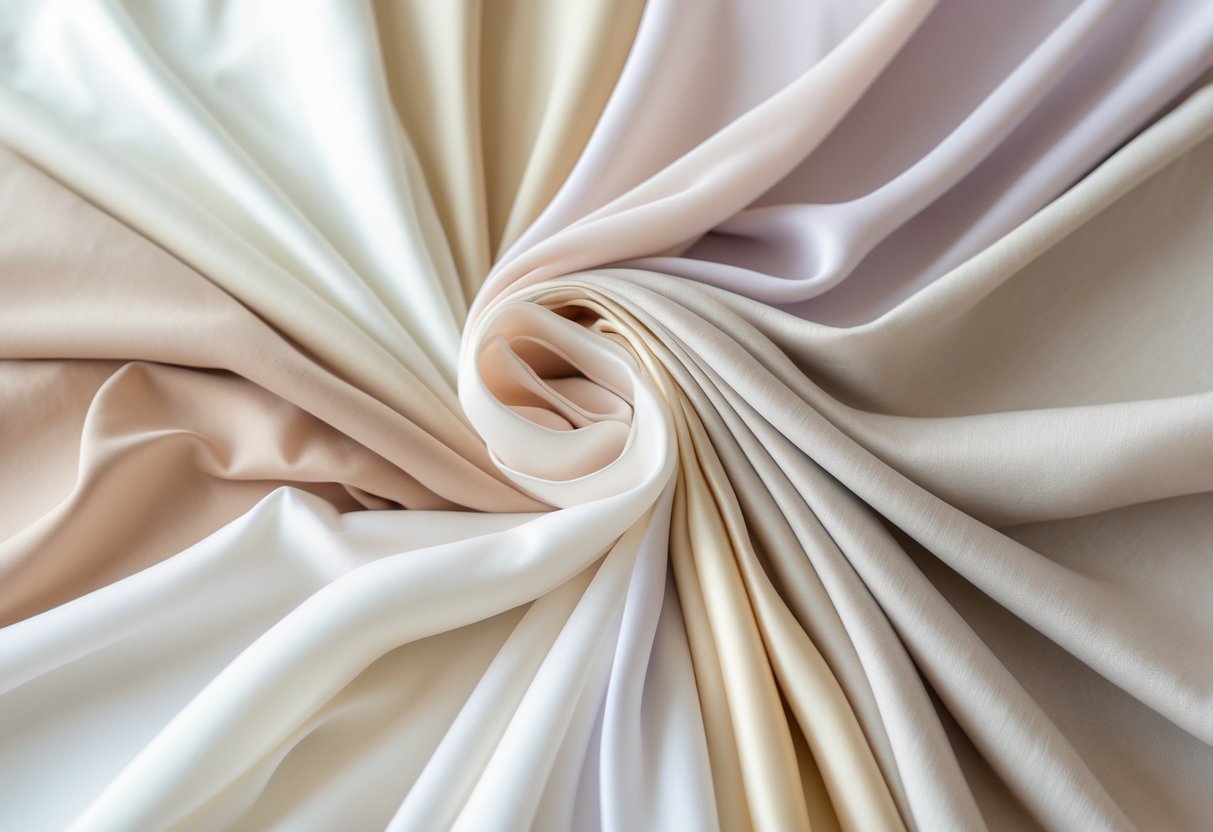
Rayon is a lightweight fabric known for its smooth texture and breathable qualities. It feels soft like cotton but drapes more like silk, making it a popular choice for warm weather clothing.
It works well for dresses, blouses, skirts, and pants because it moves easily with the body. Its ability to absorb moisture helps keep the wearer cool and comfortable.
Rayon comes in many varieties, including printed and solid colors. It is often used to create stylish, flowing garments that are both comfortable and practical.
This fabric is also appreciated for its versatility. It can be used in casual wear, formal outfits, and even lightweight home textiles. Its silky feel and breathability support all-day comfort in many settings.
8) Polyester Georgette
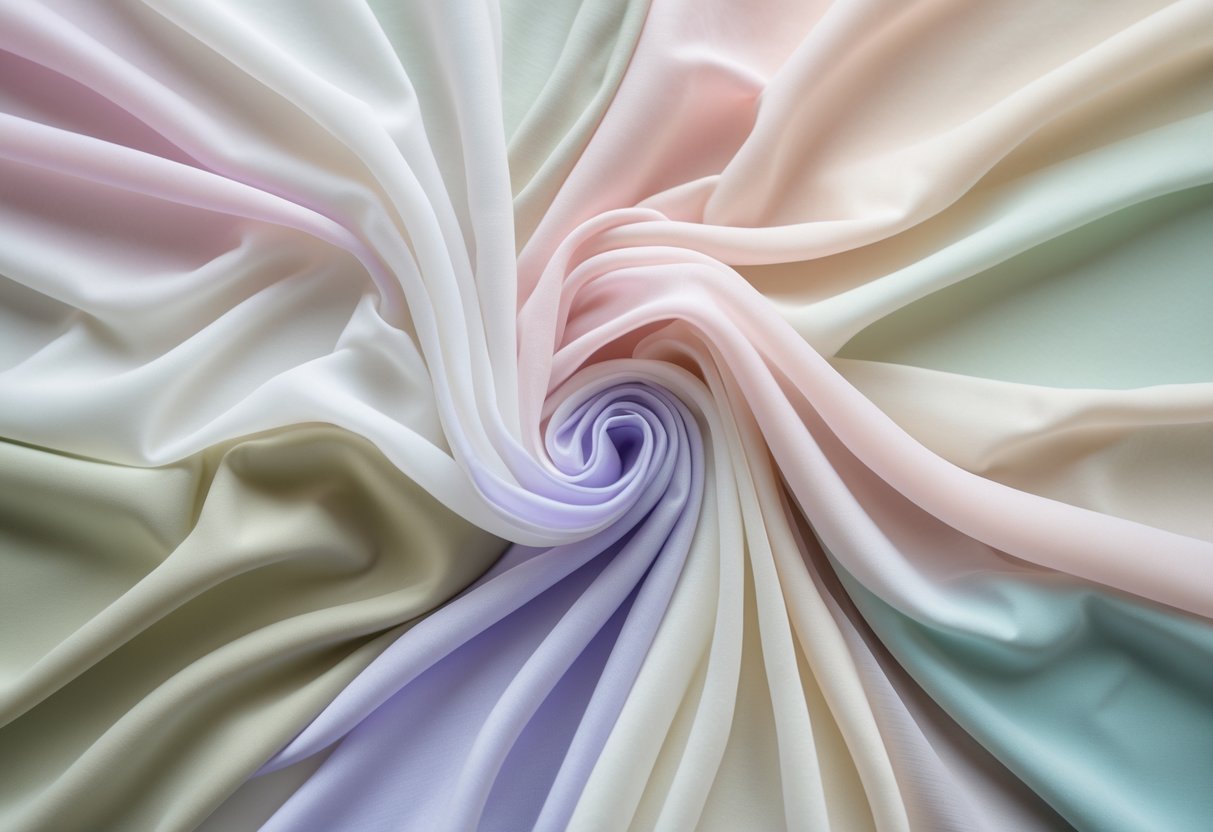
Polyester georgette is a very lightweight fabric known for its soft and flowing feel. It is made from polyester fibers, which makes it strong and easy to care for. The fabric has a slightly textured surface because of its twisted yarns.
This fabric is popular for elegant clothing such as dresses and scarves. Its light weight and smooth drape make it comfortable to wear, especially in warmer weather. It also resists wrinkles and shrinking, which helps the garment keep its shape.
Polyester georgette is semi-sheer, allowing light to pass through gently. This adds to its delicate, airy style. Designers often use it for formal and special occasion wear due to its attractive flow and finish.
It is easy to wash and usually dries quickly. This fabric’s blend of durability and softness makes it a practical choice for both casual and dressy garments.
9) Batiste
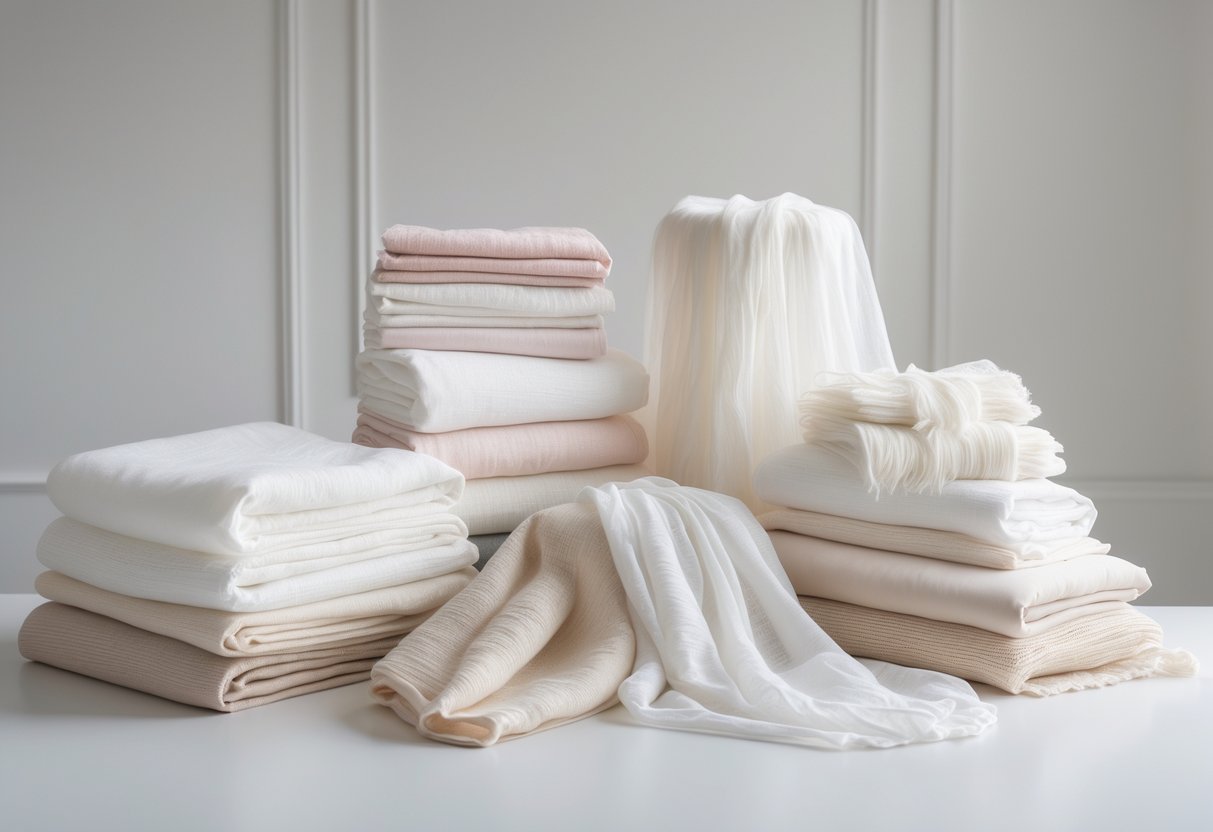
Batiste is a lightweight, semi-sheer fabric known for its soft and smooth texture. It is usually made from cotton or a blend of cotton with polyester. The fabric uses a plain weave, making it fine and closely woven.
Its light and breathable nature makes batiste suitable for warm weather clothing. Designers often use it for dresses, blouses, lingerie, and baby clothes. The fabric drapes well and feels comfortable against the skin.
Batiste also resists wrinkles and absorbs moisture, which helps keep garments looking neat. It is easy to sew, making it popular among both professional designers and hobbyists. The fabric’s origin traces back to France, where it started as a linen material before evolving into modern cotton versions.
10) Muslin

Muslin is a lightweight, plain-woven cotton fabric. It is known for its softness and breathability, which makes it comfortable to wear in warm weather. The loose weave allows air to flow easily, helping keep the body cool.
This fabric has a long history, originally made in ancient South Asia. Over time, it became popular worldwide for clothing, baby products, and home textiles. Its natural cotton fibers add to its appeal.
Muslin comes in several types, including plain, gauze, bleached, and printed varieties. Each type suits different uses, such as summer dresses, curtains, or quilting projects. It also absorbs moisture well, making it useful for both apparel and crafts.
Designers value muslin for its versatility and ease of care. It can be dyed or printed with patterns. Because it is lightweight and soft, muslin suits many styles, from casual to more formal garments.
11) Crepe de Chine
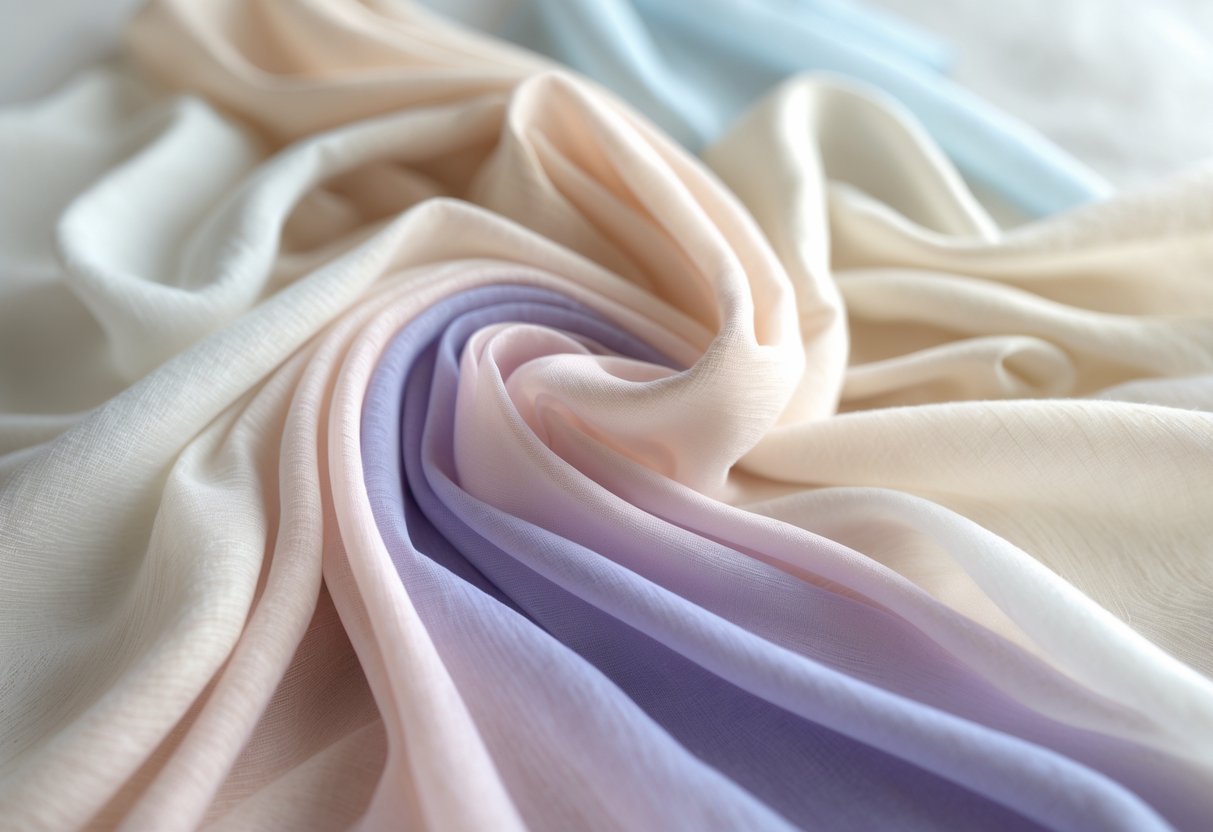
Crepe de Chine is a lightweight fabric widely used in fashion. It is made from silk or synthetic fibers and is known for its smooth, slightly textured surface.
The fabric has a soft feel and a matte finish. It drapes well, making it suitable for blouses, dresses, scarves, and linings.
Crepe de Chine resists wrinkles and allows air to pass through, which adds to its comfort. Its subtle texture is less rough than other crepe fabrics but still gives a refined look.
Designers favor it for its elegant appearance and versatility. It comes in many colors and patterns, which makes it a popular choice for different styles.
This fabric is both durable and lightweight. It works well for garments that need to look polished without adding extra weight or heat.
12) Voile

Voile is a lightweight, plain-woven fabric usually made from 100% cotton or a cotton blend. It has a higher thread count than many other cotton fabrics, which gives it a soft and smooth texture.
This fabric is breathable and semi-sheer, making it a good choice for warm weather clothing. It drapes well, adding a gentle flow to garments like dresses and blouses.
Voile comes in many colors and prints. Its lightness and softness make it popular for summer clothes, curtains, and overlays.
Due to its delicate feel, voile requires careful handling when sewing. It is easy to dye and holds patterns well, which makes it versatile for different fashion designs.
Overall, voile offers a balance of comfort and style for hot-weather wear without feeling heavy or stiff.
13) Seersucker
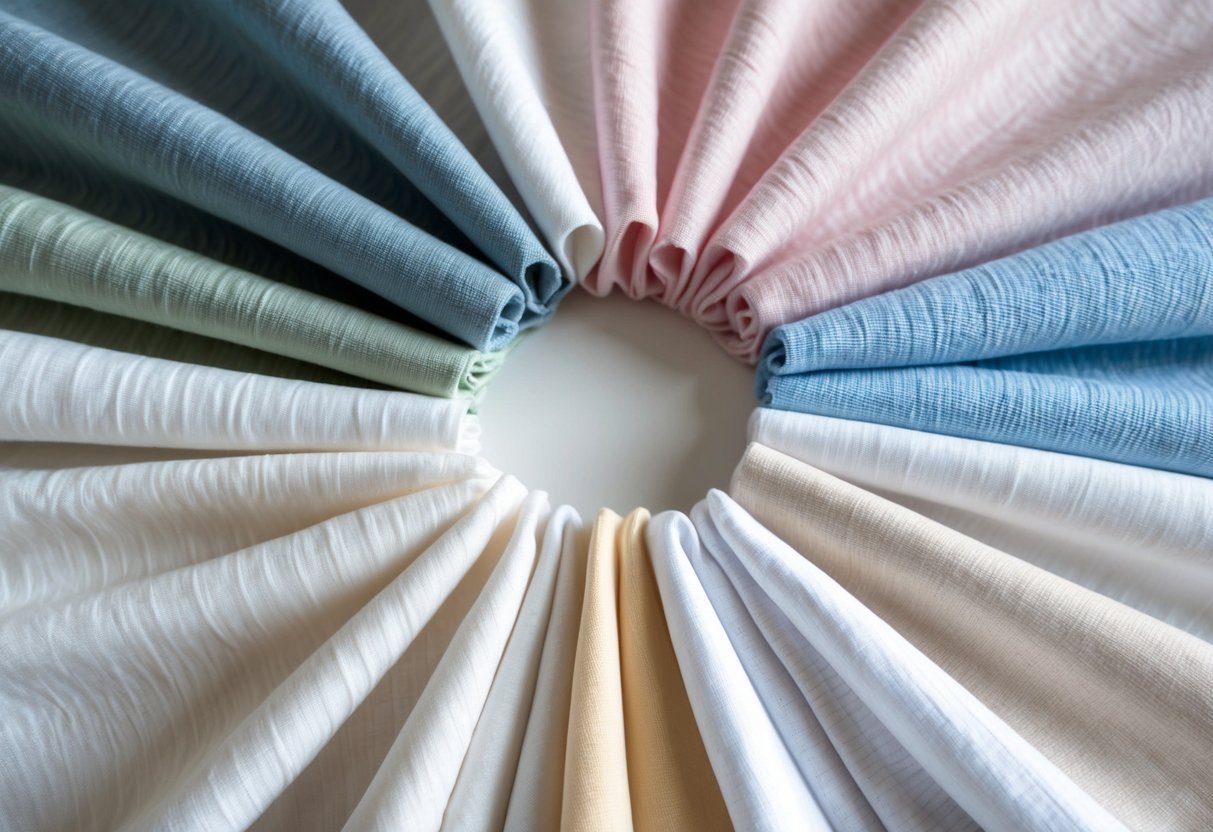
Seersucker is a lightweight fabric known for its distinctive puckered texture. This texture creates raised stripes that alternate with smooth areas, giving the fabric a slightly wrinkled look.
It is usually made from 100% cotton, which makes it breathable and comfortable to wear. The puckered areas lift the fabric away from the skin, allowing air to circulate and keeping the wearer cool.
Seersucker is commonly used in summer clothing such as dresses, suits, and casual wear. Its texture also helps hide wrinkles, making it a practical choice for warm weather.
Besides apparel, seersucker can be used in home décor items like curtains and light upholstery. Its lightweight nature and airy feel make it a versatile fabric for many summer-related uses.
Seersucker’s simple yet textured design gives classic style without extra weight. It remains popular for those looking for a durable, cool, and easy-care fabric in hot climates.
14) Jersey Knit

Jersey knit is a lightweight fabric known for its stretch and softness. It is often made from cotton, rayon, bamboo, or blends with synthetic fibers. This fabric is commonly used to make T-shirts, dresses, leggings, and loungewear.
The knit structure of jersey gives it good flexibility and comfort. It moves easily with the body and feels smooth against the skin. Jersey knit is also breathable, making it suitable for warm weather.
Its lightweight quality does not mean it lacks durability. Jersey can hold its shape well and resists wrinkling, which is why it is popular for everyday wear. Many brands prefer jersey knit for casual and active clothing.
The fabric can come in different weights, but the lightweight versions usually weigh below 150 GSM (grams per square meter). This makes jersey knit ideal for garments that need both comfort and ease of movement.
15) Gauze
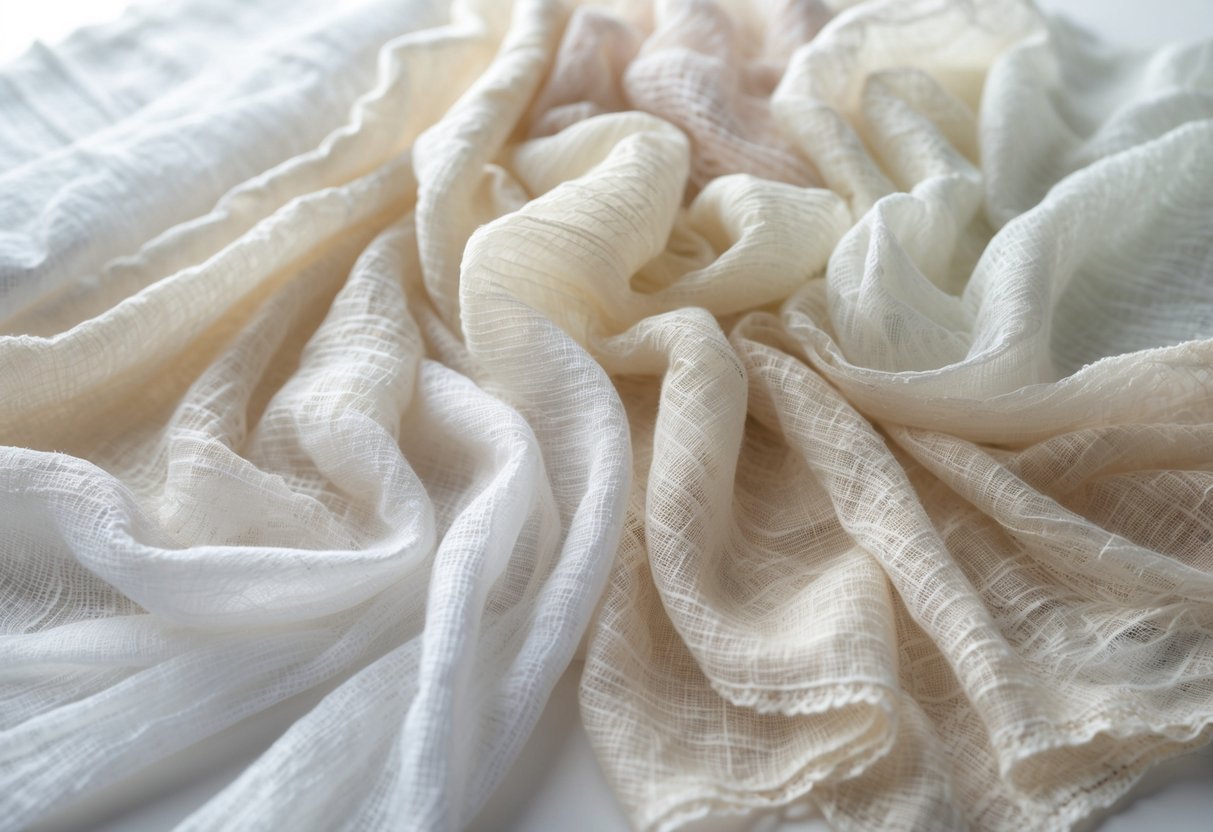
Gauze is a lightweight, sheer fabric made by weaving loose cotton threads in a simple pattern. It is known for its soft texture and breathability, making it ideal for warm weather clothing.
This fabric allows good airflow and provides comfort when worn. It is often used for blouses, dresses, scarves, and other flowing garments.
Gauze can be layered without adding bulk due to its delicate nature. It is also popular in home décor projects like curtains.
Different types of gauze include cotton gauze and double gauze, which offer added softness and durability. Its natural and organic qualities make gauze an eco-friendly choice.
Overall, gauze balances lightness and comfort well, making it a valuable option in the list of lightest fabrics for clothing and other uses.
16) Cupro
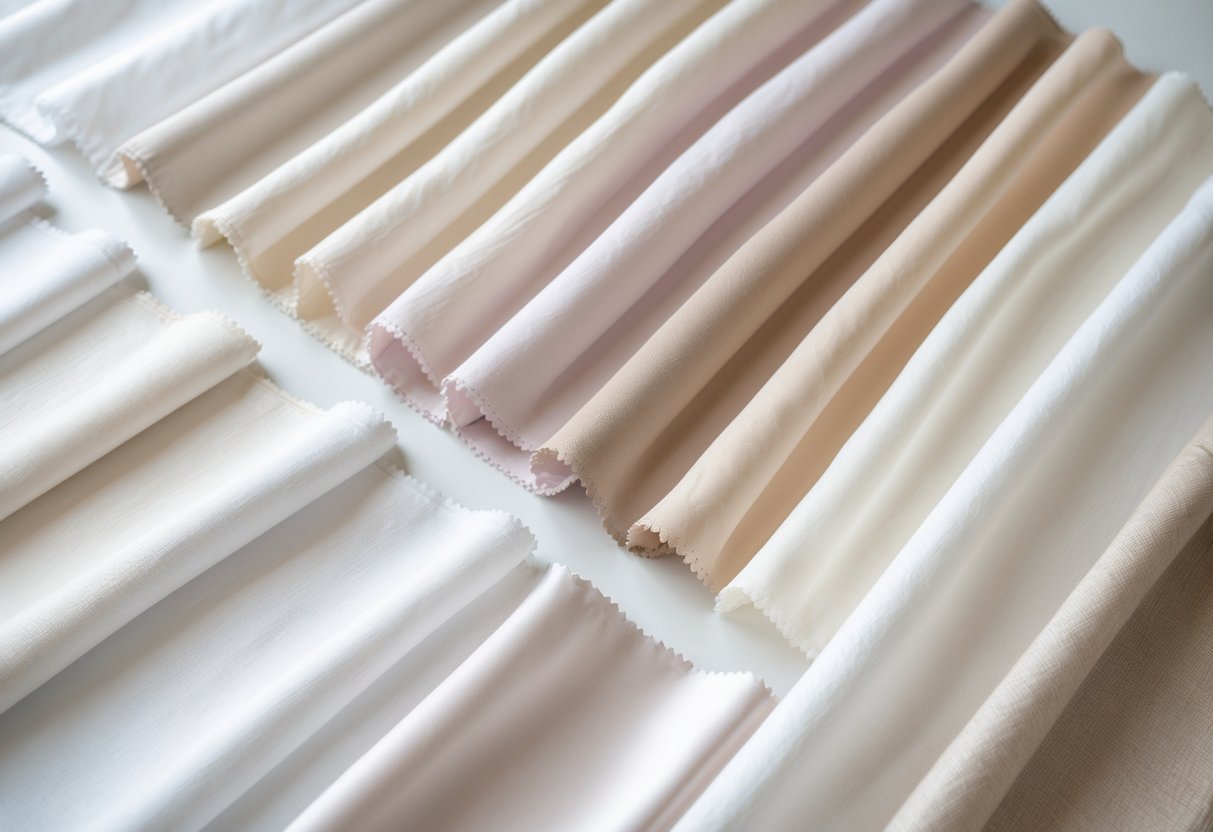
Cupro is a lightweight fabric made from cotton linter, which is a byproduct of cotton processing. It has a smooth, silky feel and drapes well. This fabric is often called “vegan silk” because it looks and feels like silk without using animal products.
It is breathable and moisture-wicking, making it suitable for warm weather. Cupro is also biodegradable and made through a process that recycles chemicals and reduces waste. This makes it more environmentally friendly than many synthetic fabrics.
Cupro fabric is popular in both high-end and casual clothing. Its softness, breathability, and elegant appearance give designers a versatile material for various styles. Since it is made from recycled cotton waste, it supports sustainability in the fashion industry.
17) Hemp Fabric
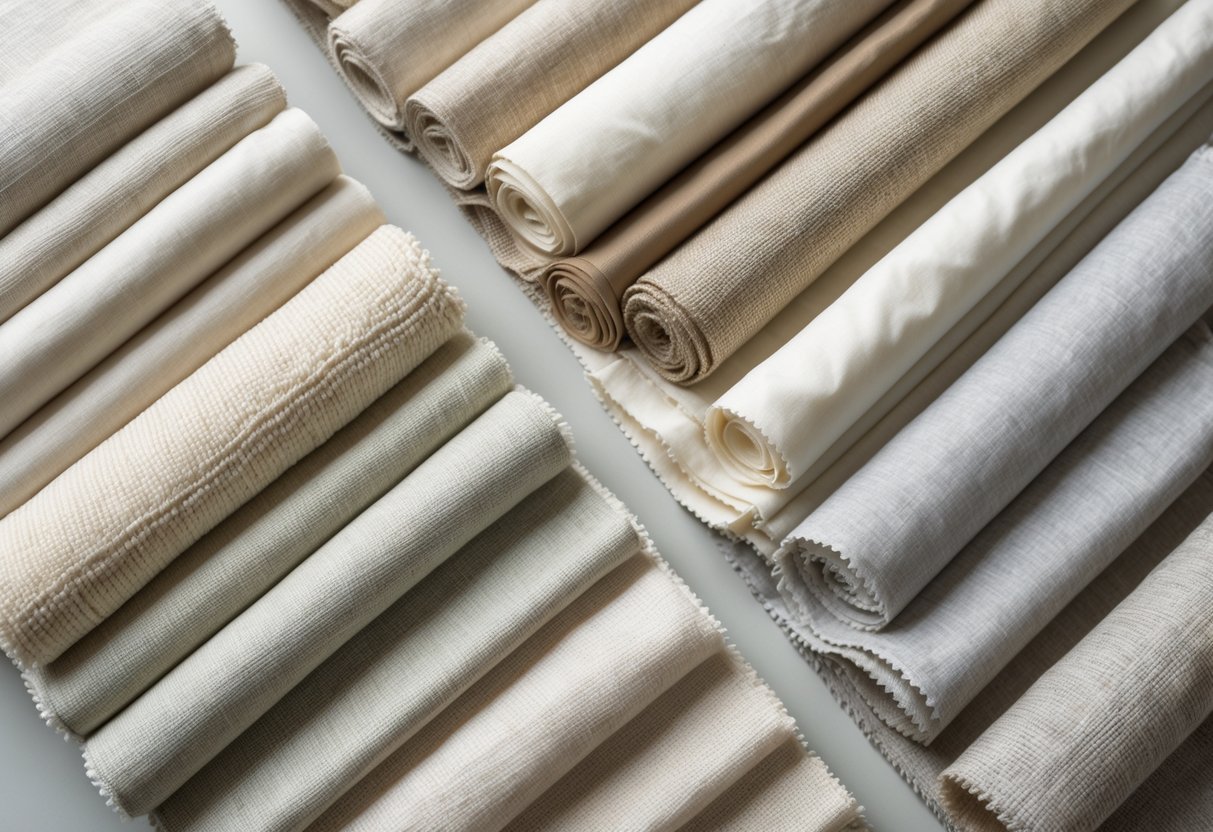
Hemp fabric is made from the fibers of the Cannabis sativa plant. It is known for being strong and durable. Despite its toughness, hemp fabric can be lightweight and breathable.
Hemp is also eco-friendly. It requires less water and fewer pesticides compared to other crops like cotton. This makes hemp fabric a sustainable choice for clothing.
The texture of hemp fabric can range from coarse to soft, depending on how it is processed. It is often blended with other fibers to improve softness, but 100% hemp fabric is available for those seeking a natural feel.
Hemp fabric resists wear and tear, which helps clothing last longer. It also has good moisture-wicking properties, keeping the wearer comfortable in warm weather.
Because of these qualities, hemp fabric is commonly used for casual wear, activewear, and eco-conscious fashion. It offers a balance of comfort, durability, and sustainability.
18) Modal
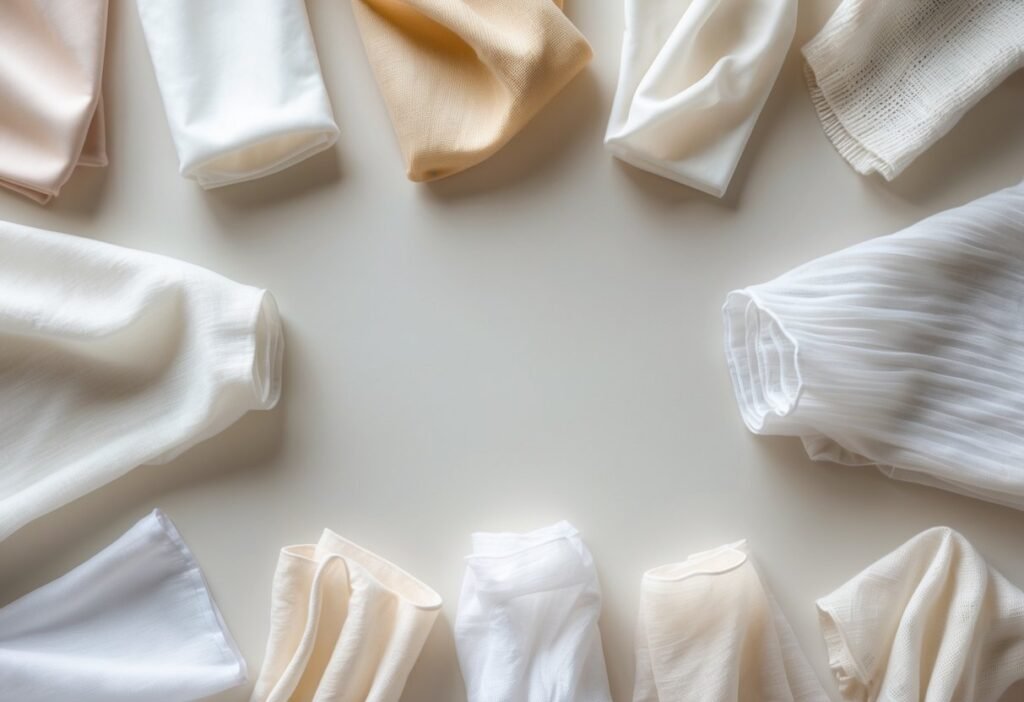
Modal is a lightweight fabric made from beech tree cellulose. It is soft, breathable, and smooth to the touch.
The fabric is known for its strength despite its light feel. It resists shrinking and fading, which helps maintain its look after washing.
Modal is often blended with cotton to improve comfort and breathability. It works well for underwear, pajamas, and light summer clothing.
Because it dries quickly, modal is good for warm weather. It does not feel sticky or heavy on the skin.
Production of modal uses an eco-friendly process compared to some other synthetic fabrics. This makes it a popular choice for those interested in sustainable textiles.
This fabric combines comfort, style, and durability in a lightweight form. It is regularly chosen for garments that need to be soft and easy to wear all day.
19) Nylon Mesh
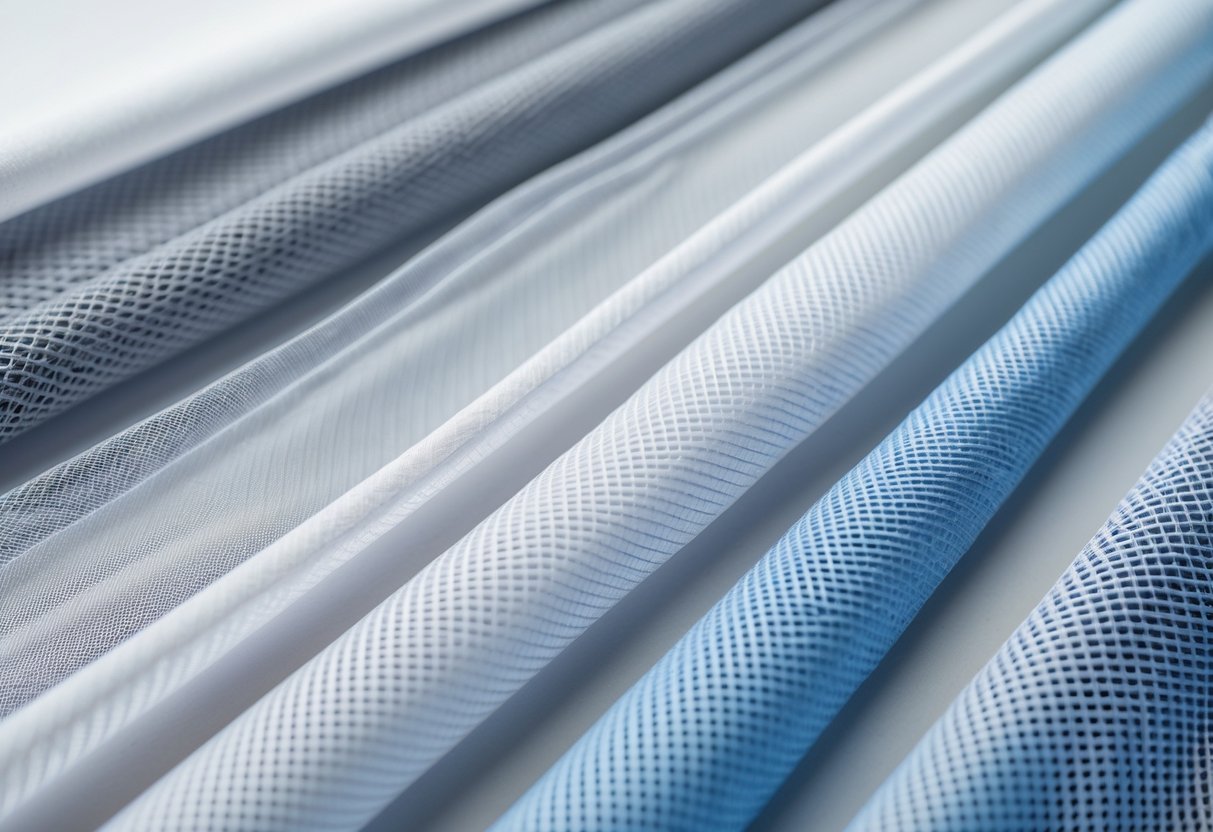
Nylon mesh is a lightweight fabric known for its breathability and durability. It has a screen-like structure that allows air to flow easily, making it a good choice for activewear and outdoor gear.
The fabric is made by weaving or knitting nylon fibers in a loose pattern. This design gives it strength while keeping it light and flexible.
Nylon mesh is often used for bags, jacket liners, and sportswear. It can also be found in items like backpacks and sunshades.
Its ability to provide ventilation while maintaining structure makes it practical for many projects. Nylon mesh comes in various colors and widths, offering options for different needs.
Because it is strong and resistant to wear, nylon mesh is suitable for both crafts and functional apparel. It balances light weight with robustness.
20) Silk Organza
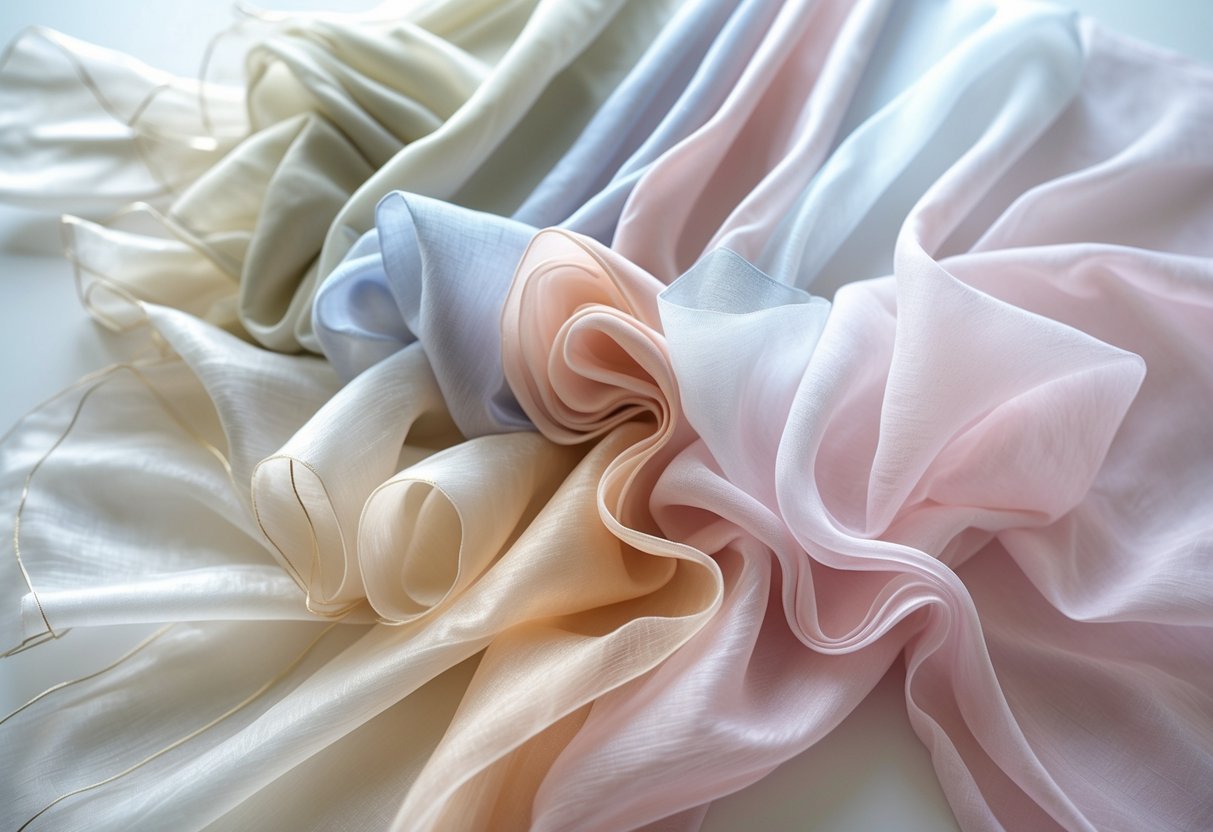
Silk organza is a very lightweight and sheer fabric. It has a crisp texture that holds its shape well. This makes it different from softer, more flowy silks.
The fabric is made with fine silk threads woven in a plain pattern. It has a smooth surface and a slight shine. This adds a delicate and elegant look to the material.
Silk organza is often used in formal clothing. It works well for wedding dresses, evening gowns, and overlays. Its stiffness lets designers create volume and structure without adding heaviness.
Besides fashion, silk organza can be used in home decor and crafts. Its strength and sheer quality make it ideal for lampshades or decorative accents.
Overall, silk organza is valued for combining lightness with a firm hand. It is a good choice when a project needs both transparency and form.
21) Chambray
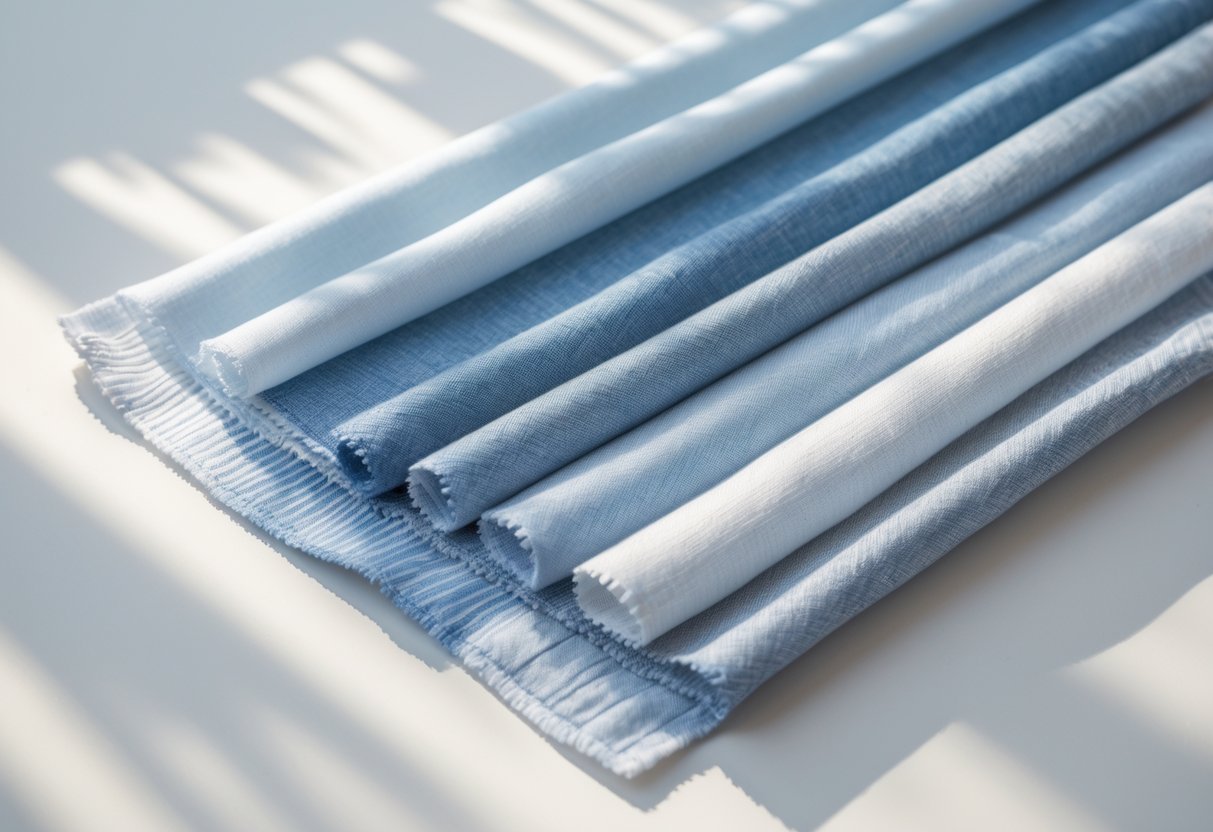
Chambray is a lightweight cotton fabric known for its soft feel and breathable quality. It has a plain weave with colored warp yarns and white weft yarns. This gives it a subtle two-tone look that is similar to denim but much lighter and smoother.
Originally from Cambrai, France, chambray has a long history and is often used for shirts, dresses, and skirts. Its light weight makes it ideal for warm weather clothing. It offers comfort without the heaviness of denim.
Chambray is easy to style and works well in both casual and more polished outfits. It is also popular in home décor for items like curtains and pillows due to its softness and classic appearance. The fabric is durable yet feels gentle against the skin.
Because of its breathable nature, chambray helps keep the wearer cool. It can be machine washed and cared for like other cotton fabrics. This makes it practical as well as stylish.
22) Georgette
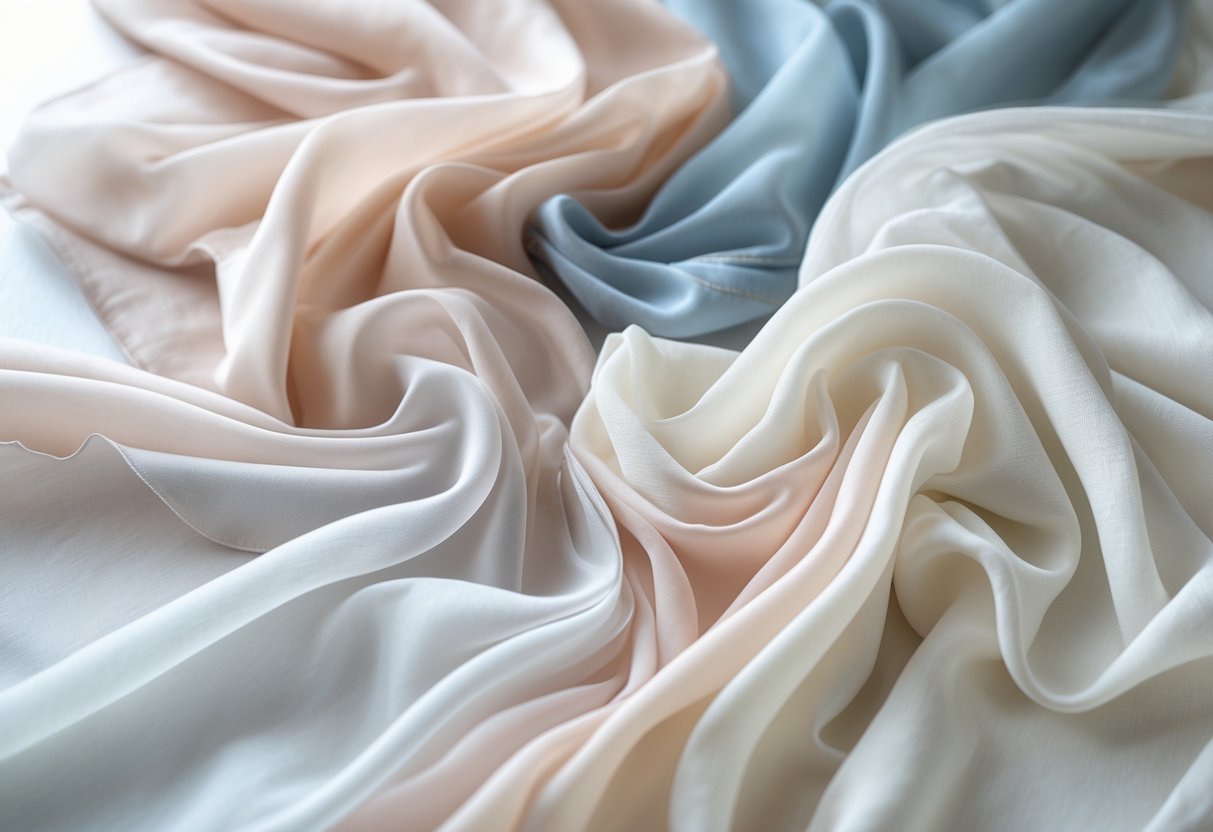
Georgette is a lightweight, sheer fabric known for its slightly crinkled texture. It is traditionally made from silk but is also commonly produced using synthetic fibers like polyester or rayon.
The fabric has a matte finish and flows with a soft drape. This makes it popular for dresses, blouses, and scarves that require both comfort and elegance.
Georgette is woven using tightly twisted yarns in different directions. This technique gives the fabric its characteristic texture and a gentle stretch.
It is durable compared to other lightweight fabrics. The texture also helps it hold vibrant colors well, making it a versatile choice for various styles.
Its lightweight nature and breathable qualities make georgette suitable for warm weather clothing. It is often seen in summer wear as well as formal outfits.
Overall, georgette blends practicality with a refined look, making it a valued fabric in fashion design.
23) Batiste Cotton
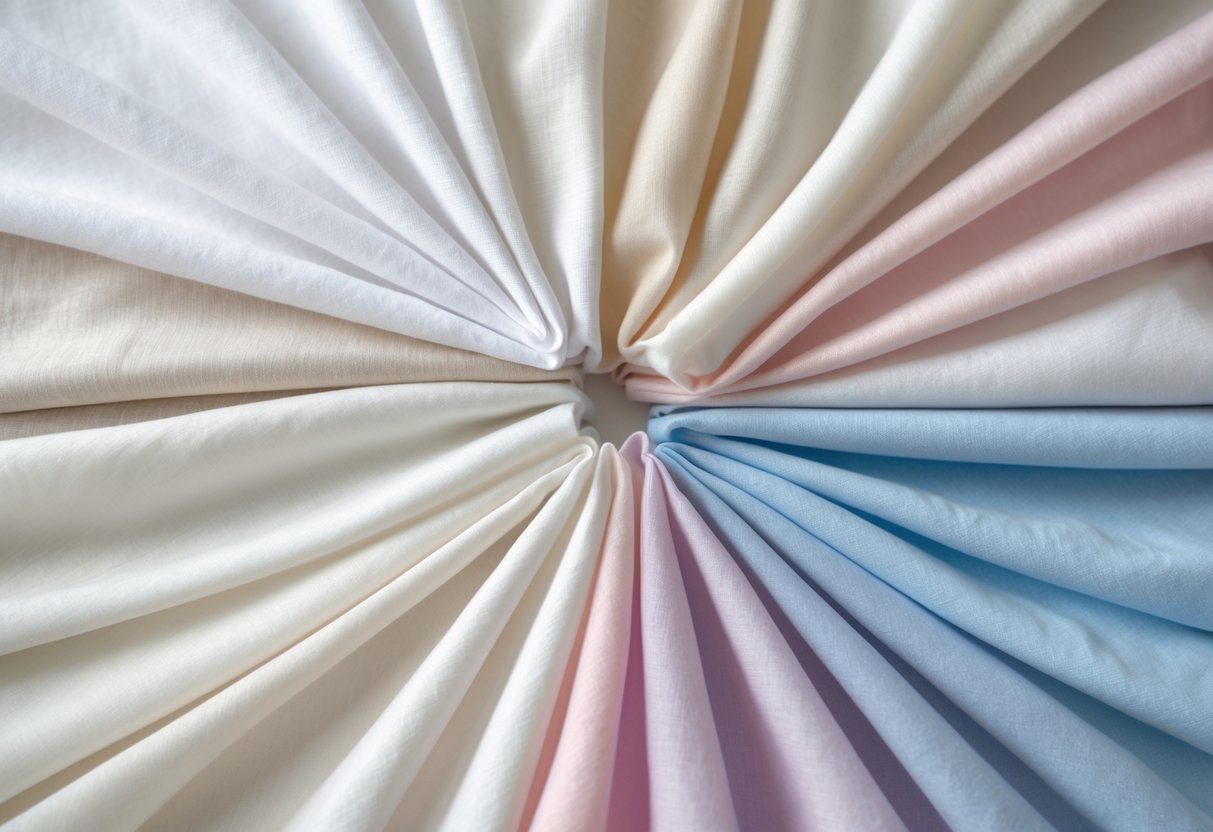
Batiste cotton is a lightweight, soft fabric made from 100% cotton. It is known for its fine texture and breathable quality, making it ideal for warm weather clothing.
The fabric has a semi-sheer appearance and a smooth finish. Designers often use it for summer dresses, blouses, and baby clothes due to its airy feel and light weight.
Batiste cotton drapes well and feels gentle against the skin. It can also serve as a lining material in high-quality garments because of its durability combined with a delicate look.
This fabric is available in a variety of colors and patterns. Its simplicity and comfort make it a popular choice for both casual and elegant styles.
24) Tulle

Tulle is a very lightweight, fine netting fabric. It is often made from nylon, polyester, or silk. The open weave creates a sheer and airy look, making it ideal for delicate and elegant garments.
This fabric is commonly used in wedding veils, tutus, and evening gowns. It adds volume without much weight, which makes it popular in layered designs. Tulle also works well for decorations and crafts.
There are different types of tulle. Some are soft and flexible, while others are stiff and hold shape better. This variety allows designers to choose the best type for their specific needs.
Tulle comes in many colors and can have added features like glitter or shimmer. It is easy to sew and shape, making it a versatile choice for both fashion and craft projects.
25) Satin

Satin is a lightweight fabric known for its smooth surface and glossy finish. It is made using a special weave that creates a shiny front and a dull back. This unique texture gives satin a luxurious appearance.
Satin can be made from different fibers, including silk, polyester, and nylon. The choice of fiber affects its weight, feel, and shine. Lightweight satin is often used in clothing where comfort and elegance matter.
This fabric is popular for dresses, blouses, and formal wear because it drapes well and feels soft against the skin. Its sheen makes it suitable for special occasions, while lighter versions work well for summer clothing.
Satin requires careful handling since it can snag or wrinkle easily. Despite this, it remains a favorite fabric for those who want a polished look with a light, smooth texture.
26) Voile Cotton

Voile cotton is a lightweight, semi-sheer fabric known for its soft feel and delicate texture. It is made from tightly woven cotton fibers, which gives it breathability and a smooth surface.
This fabric drapes well, making it a popular choice for summer dresses, blouses, and skirts. Its light, airy nature also makes it suitable for curtains and overlays in home décor.
Voile cotton is valued for comfort since it allows air to pass through easily. It works well as a lining material or for garments where a soft, flowing look is desired.
While mostly made from cotton, voile fabric can sometimes include silk or rayon blends. However, pure cotton voile remains favored for its simplicity and natural breathability.
27) Batiste Linen
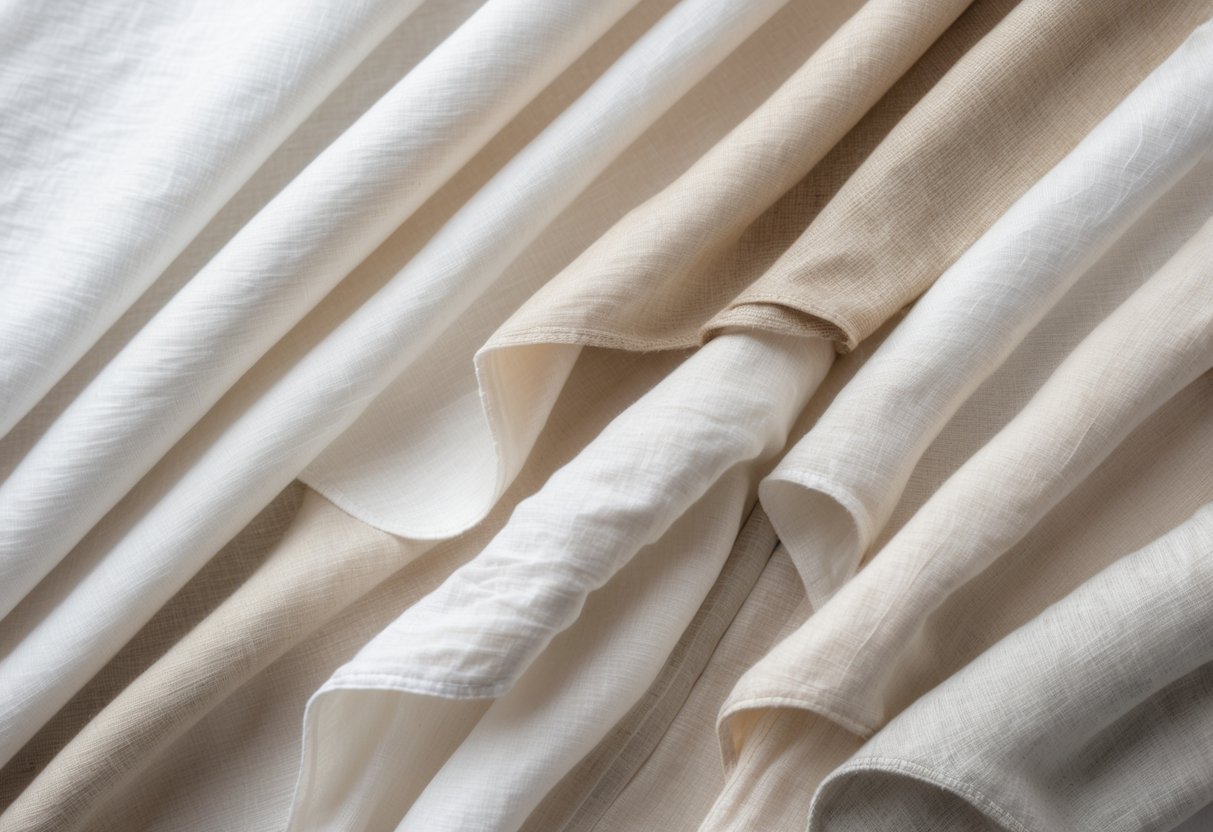
Batiste linen is a lightweight fabric known for its breathability and soft feel. It has a semi-sheer quality but remains durable like traditional linen.
This fabric is made from fine linen yarns woven tightly in a plain weave. Its lightweight nature makes it ideal for warm weather clothing and layering.
Batiste linen is often used for dresses, blouses, and summer wear. It offers comfort while maintaining a crisp, smooth texture.
Though delicate in appearance, it is strong enough for regular use. Sewing with batiste linen is straightforward, making it popular among both beginners and experienced sewers.
Because it is lightweight, adding a lining is sometimes recommended depending on the project and desired opacity. The fabric’s natural breathability keeps garments cool and comfortable.
28) Polyester Chiffon
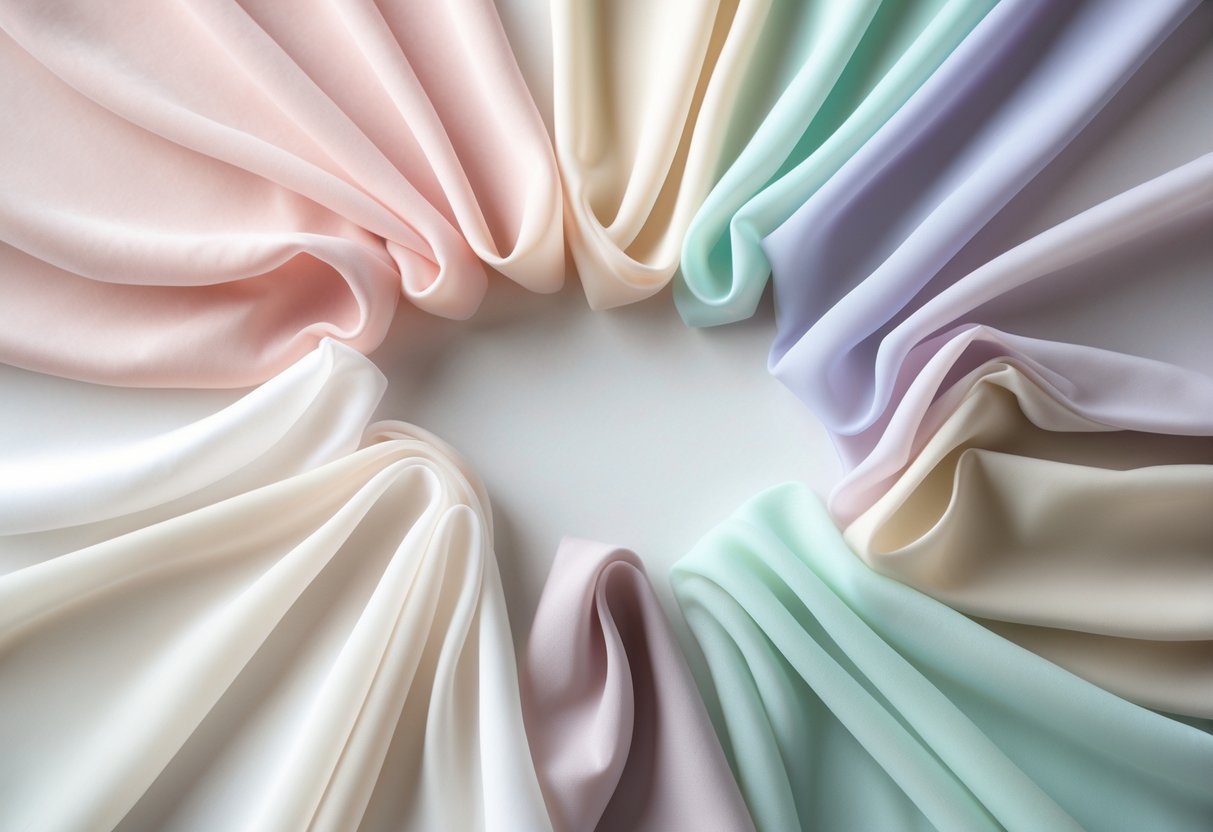
Polyester chiffon is a lightweight, sheer fabric. It has a smooth texture and a flowing drape that makes it popular for many types of clothing.
It is often used for dresses, blouses, scarves, and evening wear. The fabric moves softly and adds a delicate look to garments.
This fabric is made from 100% polyester or blends with other fibers. It is more affordable than silk chiffon but offers a similar elegant appearance.
Polyester chiffon is easy to care for and durable. It can be layered without adding weight, making it suitable for warm weather or decorative layers.
Available in many colors, polyester chiffon is a versatile fabric. It is also used in home decor, like drapes, because of its light and airy quality.
29) Lawn Cotton
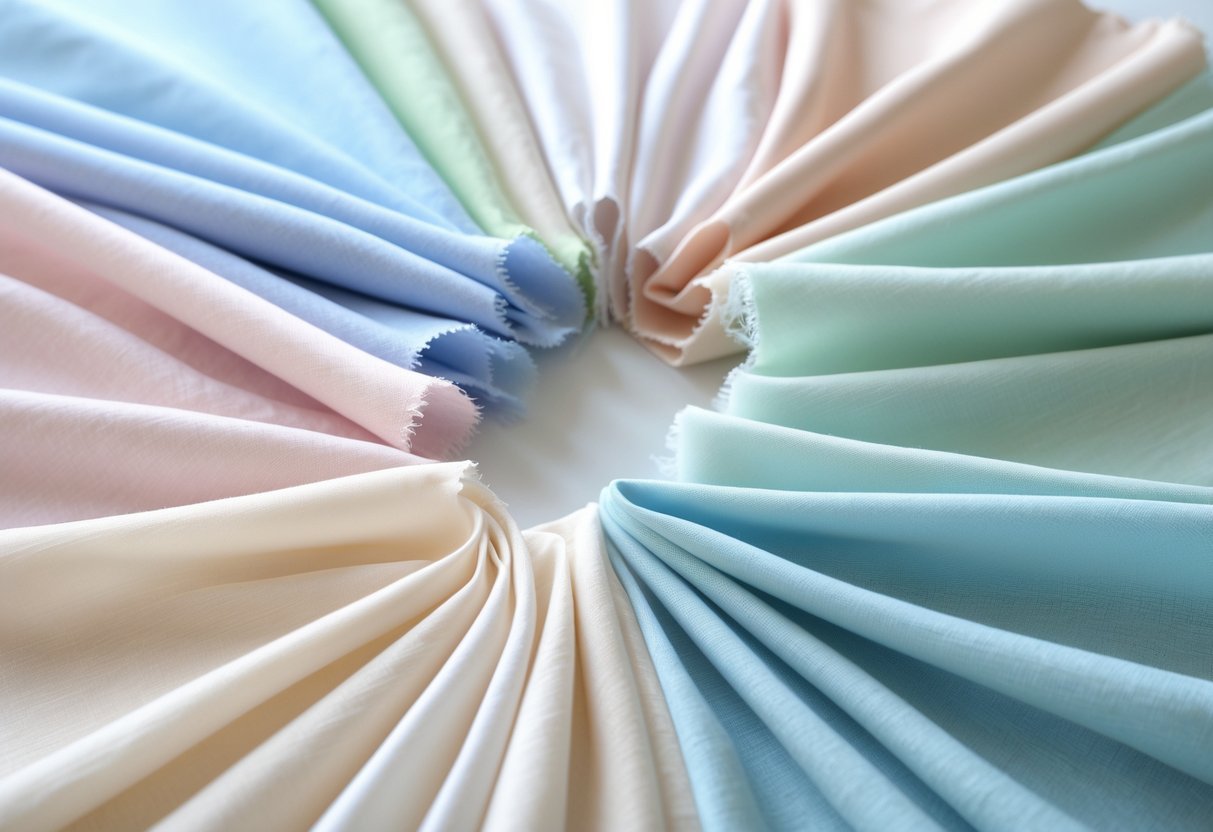
Lawn cotton is a very lightweight fabric made from 100% cotton. It is known for its smooth, crisp texture and fine weave. These qualities make it feel soft and breathable.
It is often used for warm-weather clothing like blouses, dresses, and skirts. The fabric allows air to pass through easily, which helps keep the wearer cool.
Lawn cotton is also popular for delicate home decor items and linings. Its fine weave gives it a slightly transparent look, but it can be layered to add opacity when needed.
The fabric drapes well, offering a balance between structure and flow. Designers appreciate lawn cotton for its ability to hold shape without feeling stiff.
Its lightweight nature makes it a good choice for summer or clothing worn in warm climates. It combines comfort with a polished and elegant appearance.
Understanding Lightweight Fabrics

Lightweight fabrics are chosen mainly for their breathability, comfort, and ease of wear. Their defining features relate to weight and texture, while the type of fibers used influences durability and feel. Different combinations of fibers affect how lightweight fabrics behave in various uses.
Characteristics That Define Lightest Fabrics
The weight of a fabric is measured in grams per square meter (GSM). Fabrics with lower GSM are lighter and allow better air flow.
Key features of lightweight fabrics include:
- Thin threads or yarns
- Open weaves or knits that increase breathability
- Soft textures that drape well
- Quick drying properties
Examples include chiffon, linen, silk, and thin cotton. These fabrics tend to feel airy and less dense compared to midweight or heavyweight materials. Their thinness makes them suitable for warm weather or layering without bulk.
Blends and Fiber Sources
Lightweight fabrics can come from natural or synthetic fibers. Natural fibers like cotton, linen, and silk are popular for their softness and breathability. Linen is strong but also very light, ideal for summer wear.
Synthetic fibers such as polyester and nylon are often blended with natural fibers to enhance durability and wrinkle resistance without adding much weight.
Some common blends are:
| Blend | Key Benefit |
|---|---|
| Cotton-Polyester | Durable, breathable, light |
| Silk-Nylon | Smooth feel, strong, light |
| Linen-Cotton | Breathable, soft, lightweight |
Blending fibers allows manufacturers to tailor fabrics for specific needs while maintaining a light feel.
Care and Longevity of Light Fabrics
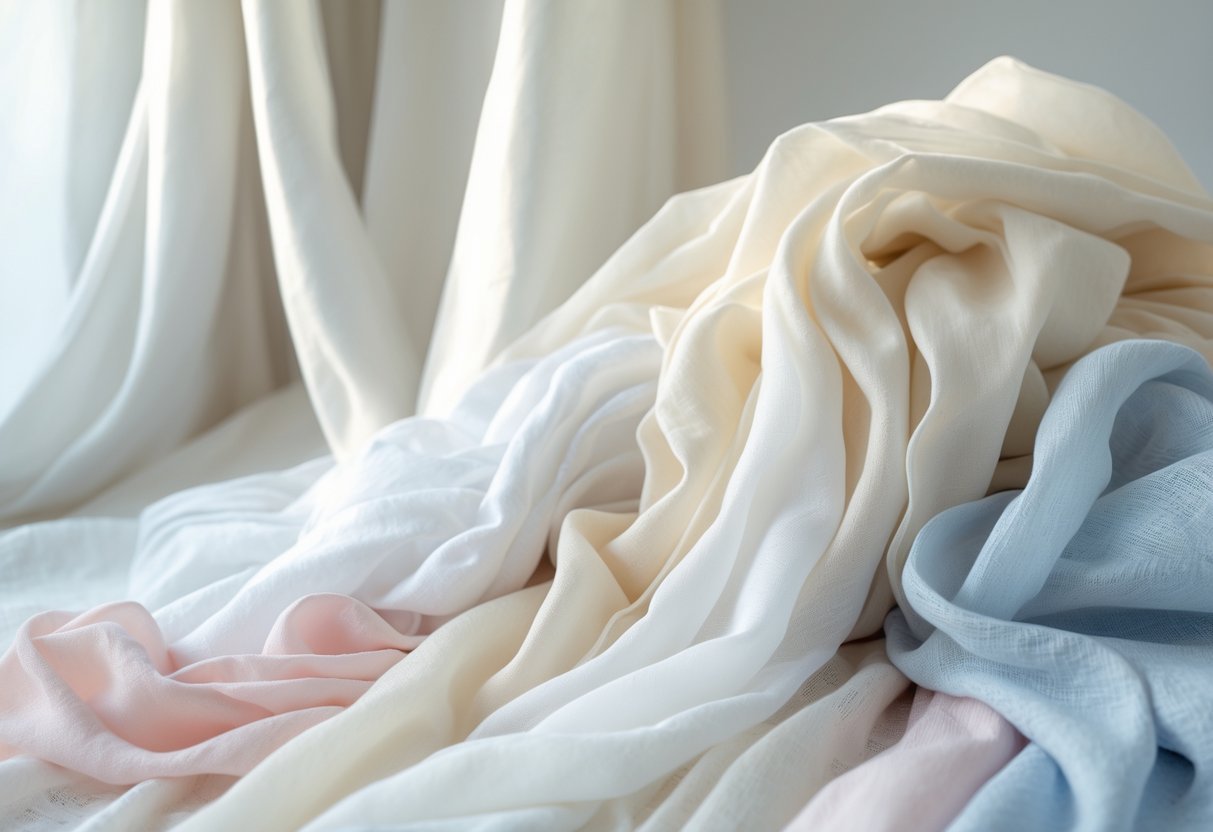
Light fabrics need gentle handling to keep their look and feel over time. Proper washing techniques and careful maintenance help preserve their shape, softness, and durability.
Best Practices for Washing
Light fabrics should be washed in cold water using a gentle cycle. Harsh detergents can weaken fibers, so mild, fragrance-free detergents are best. Avoid using bleach or fabric softeners, as they can damage delicate materials.
Hand washing is ideal for very thin or delicate fabrics. When machine washing, placing the garment in a mesh laundry bag protects it from snagging or stretching. Drying should be done by air, flat or hanging, and never in direct sunlight to prevent fading and fiber weakening.
Maintaining Shape and Softness
To maintain shape, light fabrics must be handled carefully after washing. Avoid wringing or twisting, as this can cause stretching or misshaping. Gently press out excess water instead.
Storing garments loosely folded rather than hung helps prevent stretching of delicate fibers. For soft fabrics like silk or chiffon, occasional use of fabric conditioners made for delicate fabrics keeps them smooth. It is important to store clothes in a cool, dry place to avoid moisture damage and mildew.
Frequently Asked Questions
Lightweight fabrics vary in breathability, durability, and care needs. Some fabrics work best in hot weather, while others balance lightness with strength or comfort. Ethical choices also matter for many consumers.
What are the top lightweight fabrics suitable for hot weather?
Chiffon, cotton voile, Tencel, linen, and organza are among the best fabrics for hot climates. They allow air to flow freely and help the body stay cool.
These fabrics wick moisture well and dry quickly. Linen and cotton voile are especially good for summer clothing.
How do different light fabrics compare in terms of breathability?
Linen and cotton voile offer excellent breathability due to their natural fibers and loose weave. Tencel also allows air circulation but feels smoother.
Chiffon and organza are lighter in weight but less breathable because of their tight, semi-transparent weave.
Which lightweight materials are most durable for day-to-day wear?
Linen and Tencel stand out for their durability among lightweight fabrics. Linen becomes softer with each wash but stays strong, while Tencel resists wear and wrinkles.
Chiffon and organza are delicate and better suited for special occasions rather than daily use.
What are the best washing practices for maintaining the quality of delicate, lightweight textiles?
Delicate fabrics like chiffon and organza should be hand-washed or cleaned on a gentle cycle with cold water. Use mild detergent and avoid wringing.
For linen, cotton voile, and Tencel, machine washing on a gentle cycle is fine, but air drying is recommended to preserve fabric integrity.
Can lightweight fabrics provide adequate warmth in cooler climates?
Lightweight fabrics generally do not offer much warmth on their own. Linen and cotton voile keep cool air out but are thin, so layering is needed in cooler weather.
Tencel has slightly better insulation but still requires additional layers to provide sufficient warmth.
What are the ethical and sustainable options among light textile materials?
Tencel is known for sustainability due to its eco-friendly production from wood fibers. Linen also ranks well because flax requires less water and pesticides.
Cotton voile can be sustainable if organic cotton is used. Chiffon and organza are less eco-friendly, depending on their synthetic or silk compositions.


